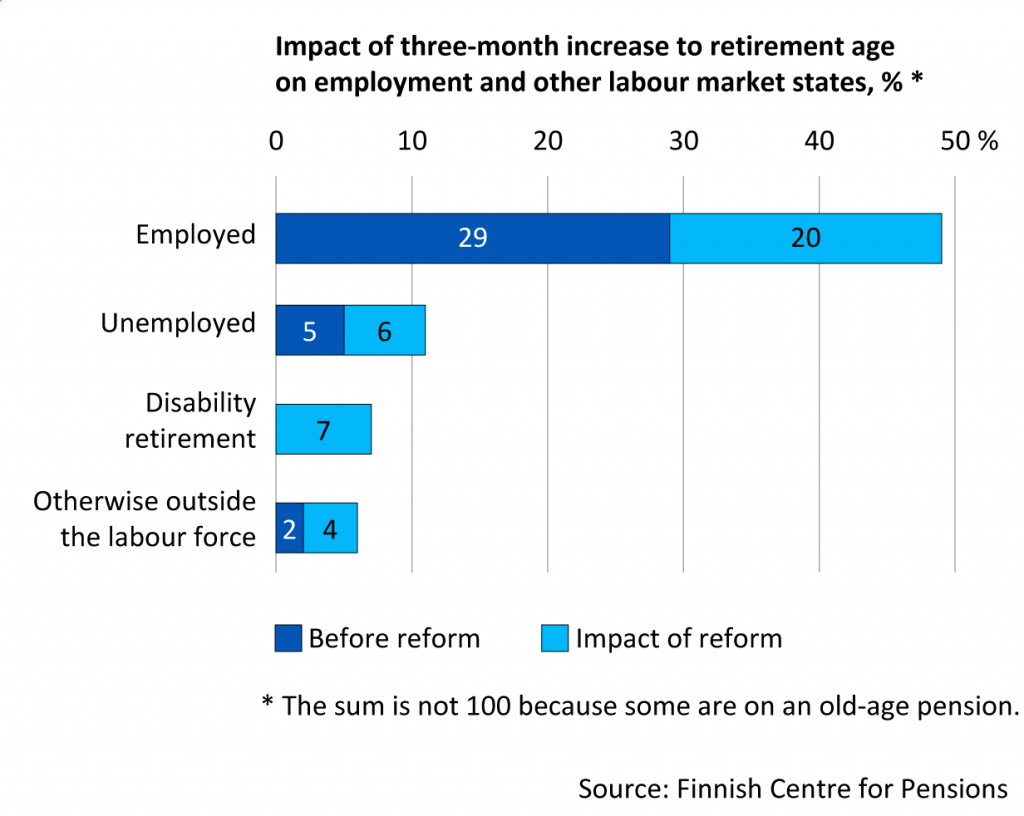Rising retirement age reflected in rising employment rate – unemployment and disability have also increased

The gradual increase of the retirement age agreed on in the 2017 pension reform has considerably raised the employment rate of those approaching their retirement age. At the same time, unemployment and disability retirement have also clearly increased, as revealed by a new study by the Finnish Centre for Pensions.
The study examines how the rising retirement age has been reflected in the shares of individuals in different labour market states – employed, unemployed, disabled or otherwise outside the labour force – between the former and current retirement age.
The data used includes all Finnish citizens born between 1954 and 1956. For those born in 1954, the retirement age is 63 years. For those born in 1955, it is 63 years and 3 months, and for those born in 1956, it is 63 years and 6 months.
Following the three-month increase in the retirement age per year, the share of persons drawing an old-age pension has decreased by, on average, 37 percentage points between the former and the current retirement age. Around half of the reduction in the number of retired people is reflected in a rising employment rate.
“As a result of the increase of three months per year in the retirement age, the share of employed persons has grown by an average of 20 percentage points to 49 per cent. In other words, the employment rate has risen 1.7-fold. The lion’s share of the growth can be explained by those of working age remaining in work longer due to the rising retirement age”, says Economist Satu Nivalainen (Finnish Centre for Pensions). The retirement age has raised the labour force exit age by 0.6 months, and a six-month increase in the old-age retirement age has deferred the exit from the labour force by 1.3 months.

Employment increased particularly in the private sector and among the low-educated
Employment has increased more in the private than the public sector. A three-month increase in the retirement age has nearly doubled the share of employed persons in the private sector compared to the time before the 2017 pension reform. In the public sector, employment has risen 1.4-fold.
The employment rate of those with a lower education has increased more than that of the highly educated. The share of employed among those with a primary education has doubled and the share of those with a higher tertiary education has risen 1.3-fold.
“In the public sector and among the highly educated, a considerably higher share of persons continued working past their retirement age already before the pension reform. That is why the employment effects of the reform in the public sector and among the highly educated are lesser”, Nivalainen explains.
Unemployment and disability retirement have also increased
Although the employment rate has increased significantly because of the pension reform, the share of persons who are unemployed, on a disability pension or otherwise outside the labour force has also increased clearly.
According to Nivalainen, the growth in unemployment and disability is mainly because people have remained longer in the labour market state they were in before the reform. Yet every tenth of those employed who, without the rising retirement age, would be retired have become unemployed or have otherwise exited the labour force.
“The rising retirement age has led to savings and higher tax income, but at the same time, the disability pension and social security expenditure has grown”, Nivalainen sums up the economic effects of the 2017 pension reform.
Research publication: 2017 pension reform: Impact of rising old-age pension on employment and other labour market states (summary in English)
